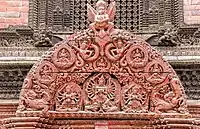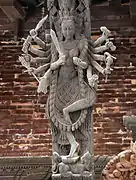Nepalese sculpture
The sculpture of Nepal is best known for small religious figures and ritual objects in bronze or copper alloy, but also has other strengths. The Newar people of Nepal had a long-lasting specialism in casting small bronze figures, mostly religious and especially Buddhist, considerable numbers of which were exported to India and Tibet over many centuries.
| Part of a series on the |
| Culture of Nepal |
|---|
 |
| History |
| People |
Stylistic history
Though the most common survivals are small figures, for reasons of climate and history, Nepal also has an unusual quantity of surviving large sculptures in wood and bronze, which have mostly been lost in India, where significant quantities of metal sculpture from temples have only survived in Tamil Nadu and other parts of the far south. Though there are small figures similar to those in bronze, most woodcarving is architectural, including the elaborate Newar windows.
Nepali sculpture draws influences from the sculpture and artistic styles of Indian art, of the Gupta and Pala Empires in particular.[1] The majority of the surviving sculptures depict religious figures and subjects, drawn from both Hinduism and Buddhism, as the two religions have coexisted peacefully in the Nepalese region for over two thousand years.[1]
Although drawing on the sculptural traditions of India, and the religious iconography of Buddhism and Hinduism, Nepalese sculpture evolved into its own distinctive style, with a tendency towards more ornate flourishes, exaggerated physical postures and elongated depictions of facial features.[1] In Nepal, as in Tibet, "the last phase of Buddhist art in India enjoyed a prolongation of nearly a thousand years",[2] as Buddhism virtually disappeared in India itself. Style in metal continued to develop until recent centuries,[3] until about the 17th century, after which it changed little.
Newar artists
Historically, Newars mostly followed a distinct non-monastic form of Newar Buddhism, and had their own caste system. As in medieval India, artists worked on both Hindu and Buddhist sculptures, in very largely the same style. They mostly lived in the Kathmandu valley.
Araniko, known mainly as an architect and painter, but also a sculptor in bronze, is the best-known Newar artist. In 1278 he led a group of 60 (or 80) Newar craftsmen, mostly metalworkers, sent to Tibet, and subsequently the court of Kubilai Khan in China, where he remained.[4]
The Licchavi period, named after the ruling Licchavi family, spanned 400-750 AD.[5] A sculpture of Baman Tribikram erected by Lichchhavi king Man Dev is considered to be the oldest sculpture in Nepal. Sculptures that were created during the Licchchhavi period include ones of Palanchowk Bhagawati, Budhanilkantha, etc. The statues inside Changu Narayan Temple and around it, statue of Palanchowk Bhagawati, statue of Budhanilkantha are few examples of sculptures made during the Licchchhavi period of time.[6]
Malla period
The rulers of the Malla period (c. 1201–1779 CE) patronized both Buddhist and Hindu beliefs and traditions, which led to both forms of religious iconography flourishing in art and sculpture.[7] The Newar people that originally inhabited the Kathmandu Valley traveled extensively through the region and became the dominant influence in terms of artistic style throughout the region and extending out through the Himalayas.[7]Works of deities including Ganesha, Shiva, Vishnu, Surya, Laxmi, Saraswati, Gautama Buddha, etc. were created during this period. Other figures of kings and gods were also common pieces. Advancements in technique included the development of molding, the sculpting of clothing ornaments, and themes based on Tantric thought and practice.
Examples
 Bronze statue of King Bhupatindra Malla of Bhaktapur from the 18th century, presently at the National Museum of Nepal
Bronze statue of King Bhupatindra Malla of Bhaktapur from the 18th century, presently at the National Museum of Nepal One of the Matrikas, Nepal, gilt-bronze, 14th century. The pendent foot "rests" on a small lotus throne, itself unsupported.
One of the Matrikas, Nepal, gilt-bronze, 14th century. The pendent foot "rests" on a small lotus throne, itself unsupported. Bronze rat (vehicle for Ganesha), Patan Museum
Bronze rat (vehicle for Ganesha), Patan Museum.jpg.webp) Guardian lions, Mani Keshar Chowk, Patan
Guardian lions, Mani Keshar Chowk, Patan.jpg.webp) Monkey, Hiranyabarna Mahavihar, Patan
Monkey, Hiranyabarna Mahavihar, Patan Wooden tympanum at entrance of Kumari House- Basantapur, Kathmandu
Wooden tympanum at entrance of Kumari House- Basantapur, Kathmandu Wood carved roof decoration on the Chandeshwari Temple
Wood carved roof decoration on the Chandeshwari Temple The Goddess Ganga, Patan, Durbar Square
The Goddess Ganga, Patan, Durbar Square Seated Buddha, 17th century
Seated Buddha, 17th century Hevajra statue, 19th century, gilt bronze
Hevajra statue, 19th century, gilt bronze
Notes
- Selig Brown, Katherine. "Nepalese Sculpture". Heilbrunn Timeline of Art History. The Metropolitan Museum. Retrieved 19 November 2017.
- Rowland, 232
- Harle, 474
- Harle, 474
- ""Himalayan Region, 500–1000 A.D." In Heilbrunn Timeline of Art History". The Metropolitan Museum of Art. The Metropolitan Museum of Art. Retrieved 19 November 2017.
- Nepalese sculptures history on blogspot about Nepal
- "Nepal: Early Malla Period Sculpture". Himalayan Art Resources. Himalayan Art Resources Inc. Retrieved 19 November 2017.
References
- Pal, Pratapaditya. 1970. Vaisnava Iconology in Nepal: A Study in Art and Religion. (Calcutta: The Asia Society).
- Pal, Pratapaditya. 1974a. Buddhist Art in Licchavi Nepal. Marg Publications. Vol. 27. No. 3 (June 1974).
- Pal, Pratapaditya. 1974b. The Arts of Nepal, Part I: Sculpture. (Leiden: E. J. Brill).
- Pal, Pratapaditya. 1978. The Arts of Nepal, Part II: Painting. (Leiden: E. J. Brill).
- Slusser, Mary Shepherd. 1982. Nepal Mandala. Two Vols. (Princeton, New Jersey: Princeton University Press).
- Bangdel, Lain S. 1982. The Early Sculptures of Nepal. (New Delhi: Vikas Publication).
- Bangdel, Lain S. 1987. 2500 Years of Nepalese Art. (Leipzig: VEB A. Seemann Verlag).
- Bangdel, Lain S. 1987. Zweitausendfünfhundert Jahre nepalesische Kunst. (München: List Verlag).
- Schick, Jürgen. 1989. Die Götter verlassen das Land: Kunstraub in Nepal. (Graz: Akademische Druck- u. Verlagsanstalt).
- Bangdel, Lain S. 1989. Stolen Images of Nepal. (Kathmandu: Royal Nepal Academy).
- Bangdel, Lain S. 1995. Inventory of Stone Sculptures of the Kathmandu Valley. (Kathmandu: Royal Nepal Academy).
- Bangdel, Lain S. and Aryal, Mukunda Raj. 1996. A Report on the Study of Iconography of Kathmandu Valley and their Preservation and Protection. (Kathmandu: Department of Archaeology, Nepal, 2053 [1996]).
- Schick, Jürgen. 1998. The Gods are Leaving the Country: Art Theft From Nepal. [Revised English Edition]. (Bangkok: Orchid Press, 1998).
- von Schroeder, Ulrich. 2019. Nepalese Stone Sculptures. Volume One: Hindu; Volume Two: Buddhist. (Visual Dharma Publications, 2019). 1556 pages with 2960 illustrations (duo-tone with numerous colour illustrations); 345 x 240 mm; bound with slipcase. Includes glossary, bibliography, chronological table, and index. SD card with more than 15,000 digital photos. ISBN 9783033063815

